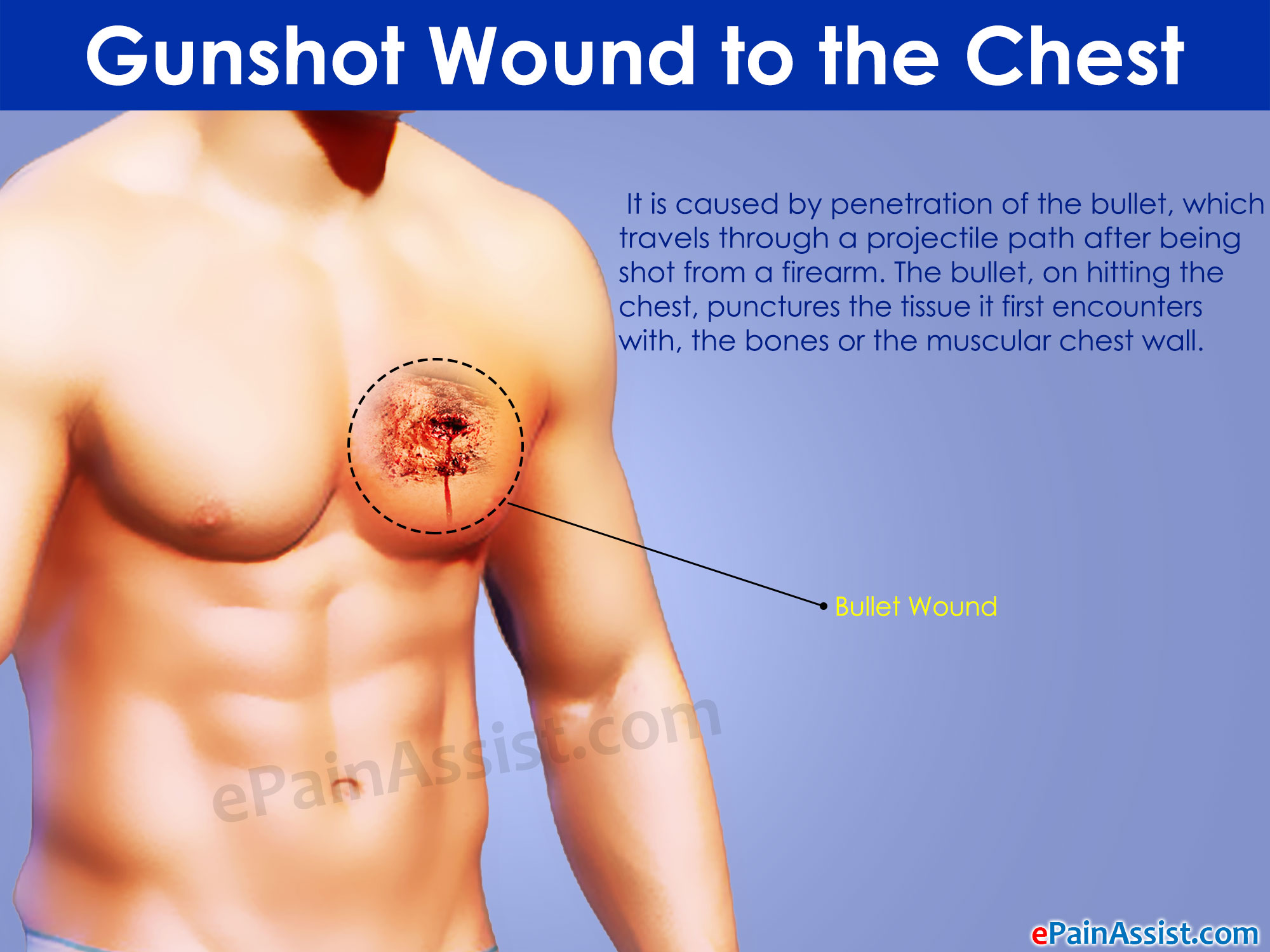Gunshot wounds have become increasing common in urban cities and many such cases can lead to undesirable outcomes. While gunshot wounds to the head are considered most lethal, gunshot wounds to the chest too may be dangerous. Gunshot wound to the chest is challenging owing to the presence of vital organs like lungs, heart and their surrounding structures including major blood vessels.
Gunshot wound is caused by penetration of the bullet, which travels through a projectile path after being shot from a firearm. The bullet, on hitting the chest, punctures the tissue it first encounters with, the bones or the muscular chest wall. The extent and severity of the injury depends on the characteristics of the bullet and the firearm, the position and the distance of the victim, the projectile path and the nature of the tissue penetrated.
Penetrating Injury to the Chest and Its Complications
In a gunshot injury, a bullet can cause entry and exit wound, and the possibility of injuries varies. Bullet injuries are usually considered to cause medium to high velocity injuries depending on the weapon. If there is an entry wound and a corresponding exit wound is not detected, it is considered that the bullet is within the body, which can cause more damage and even enter into circulation; hence demands timely identification and management.
The thoracic cavity is covered by ribcage in the front and spine at the back. It comprises, heart, lungs and major vascular structures. Additionally, in the middle there is trachea, bronchi and esophagus, while the lower ends cover the upper parts of the abdominal structures like stomach, liver, spleen, and kidneys.
The exact nature of injury varies with the area affected. Common injuries like open chest wounds (sucking chest wounds) can result due to large wound in the chest wall. These wounds are open and suck in more air, increasing the chances of lung collapse on the side injured.
A bullet can hit the rib and can cause cracking or fracture of the ribs; multiple rib fractures can occur. The bullet can hit the vital organs like lungs or pleura. This is a common injury in gunshot wound to the chest, when a bullet gets lodged into the pleural cavity or even the lung tissue. In such cases, the chances of hemorrhage as well as infection are high. Complications due to retention of the bullet in the lung can cause severe damage.
The location of injury is critical and may help in guiding emergency medical care. Organs located in the thoracic cavity, neck and peritoneal viscera are at risk if injured. Some of the common injuries noticed in gunshot wounds to the chest include hemothrorax, pneumothorax or both, rupture of diaphragm, bruising of lungs, subcutaneous emphysema, tearing of thoracic wall and fracture of breastbone. The consequences and the severity of these injuries depend on the nature and location of injuries, other related injuries and condition of the patient.
Treatment For Gunshot Wound To The Chest
Gunshot wound to the chest can cause the patient’s condition to deteriorate rapidly, hence emergency care and assessment done immediately can help. It is important to look for airways, breathing and circulation (ABCs). The patient may present with rapid breathing, use of accessory breathing muscles, stridor and anxiety in case of airway obstruction. Other important signs to be noted are breath sounds, location and intensity of pain, patient’s alertness, mental status, confusion, pulse and respiratory rate, blood pressure and bluish discoloration or cyanosis.
Sucking chest wounds can cause dyspnea, chest pain and reduced breathing. This requires immediate treatment to prevent hypoxia. The open wounds need to be covered with appropriate sterile dressing to prevent air entry through the opening. A procedure called chest tube insertion is required and may be followed by chest wall surgery. In chest wounds, the airways should be established for normal ventilation; any blood or mucus is aspirated. If additional injuries are present, tracheostomy may be performed.
Needle aspiration of the pleura or pericardial space may be performed as appropriate. Chest x-rays, generally performed after the patient is stabilized, may reveal additional injuries. Focused abdominal sonography for trauma (FAST) may help in identifying intraabdominal injuries. Other investigations like arterial blood gas analysis, pulse oximetry, CT scan may be performed.
If wounds to trachea or bronchi are suspected, esophagoscopy and bronchoscopy may be performed. Large amounts of air and blood loss could indicate injury to trachea, bronchi or major blood vessel and may require thoracotomy. Thoracoscopy, which is a video-assisted surgery, may be performed for the management of chest gunshot wounds. Underlying medical conditions and associated injuries are appropriately treated.
Prognosis of Gunshot Wound To The Chest
When gunshot wound to the chest cause intrathoracic injuries and if there are additional intraabdominal injuries, it may lead to excess hemorrhage and peritonitis. In such cases, treatment becomes more challenging and the chances of death are high. Complications like cardiac temponade, where blood fills into the pericardium can be fatal if not identified and treated appropriately at right time.
- Journal of Emergencies, Trauma, and Shock – Management of Chest Gunshot Wounds: https://www.ncbi.nlm.nih.gov/pmc/articles/PMC3226539/
- Medscape – Gunshot Wound Care: https://emedicine.medscape.com/article/2052789-overview
- Trauma.org – Gunshot Wound to the Chest: https://www.trauma.org/archive/injury/gswchest.html
- American College of Surgeons – Gunshot Wound to the Chest: https://www.facs.org/~/media/files/education/patient%20ed/gswchest.ashx
- StatPearls – Ballistics and Gunshot Wounds: https://www.ncbi.nlm.nih.gov/books/NBK534838/

